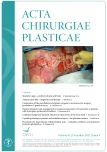Celebrating the career and retirement of Dr Hana Řihová
Authors:
Lipový B.
Authors‘ workplace:
Department of Burns and Plastic Surgery, University Hospital Brno
Published in:
ACTA CHIRURGIAE PLASTICAE, 63, 4, 2021, pp. 205
Category:
Dr Hana Řihová graduated from the Faculty of Medicine of Jan Evangelista Purkyně University in Brno in 1979. Her interest in surgery led her to the first clinical appointment. In 1979, she took up the position of a physician at the Department of Surgery, Hospital Nové Město na Moravě and, subsequently, at the Surgical Department of the Military Hospital Brno. In 1981, she started working as a secondary physician at the Department of Plastic Surgery in Brno. Due to several major events and mass accidents in local heating plants in the late 1970s, it was necessary to build from scratch a specialized Burns Unit at the Trauma Hospital in Brno. Together with the Head Physician Vladimír Michálek, she was the central person of this effort in 1982; at the same time, she found interest in this field, which subsequently became her lifelong mission. This burns unit began to provide complex centralized care for adult burn patients. In 1989, the unit was moved from the Trauma Hospital to the newly completed Brno University Hospital in Brno-Bohunice, where a standalone Burns Centre was established.
This centre broadened its scope to providing complex care for patients with thermal trauma as well as with conditions of extensive non-thermal loss of skin cover (toxic epidermal necrolysis, skin manifestations of meningococcal sepsis, etc.) not only in adult patients, as was the case in the Trauma Hospital, but also in children. This was to a large degree enabled by the arrival of the paediatrician Dr Ivan Suchánek and a team of paediatric nurses from the Department of Paediatric Medicine at University Hospital Brno. Thus, in the early 1990s, a stable team of the pioneers of burn care in Brno was formed: Dr Hana Řihová, Dr Ivan Suchánek, Dr Pavel Brychta, Dr Yvona
Kaloudová and Dr Martin Jonášek. Thanks to their unrelenting enthusiasm and work commitment, which seems almost impossible from today's perspective, it was possible to gradually recruit other doctors, expand the range of provided services and ensure comprehensive erudition in this very complicated and multidisciplinary field of medicine.
Dr Řihová took the most complicated role, i.e. the head of the intensive care unit providing intensive treatment to patients with severe and critical thermal trauma, and patients with inhalation trauma requiring different levels of organ support. Thanks to the contacts abroad and internships of individual team members, it was possible to raise the standards of burn care at this department to the level of advanced centres in Europe and North America. The need for precise microbiological surveillance in burn patients was one of the key topics emphasized by Dr Řihová; for this reason, she created a system of sophisticated antimicrobial control. Despite her focus on intensive care, she also excelled in the operating room as an outstanding surgeon with great sensitivity in the surgical treatment of acute burns as well as in reconstructive procedures, drawing on her high-level surgical training in both general and plastic surgery.
Although she herself did not seek active participation in congresses, she was always ready to contribute to the quality of lectures or publications with her knowledge, experience and valuable advice. I myself remember that my academic beginnings were often accompanied by her harsh criticism of my presentations; in retrospect, however, I am very grateful for all her objections. Personally, I respect Dr Řihová from many perspectives and in my clinical practice, her words have come back to me many times. Of all her qualities, the one that was perhaps the most important to me is her openness and willingness to pass on her years of experience to younger colleagues, keeping nothing just to herself. Thanks to this, she educated or helped to educate many outstanding professionals.
By the end of 2020, she took a well-deserved retirement, having devoted a hardly believable 38 years to her work; during that time, she managed to return several thousand burn patients to normal life with an acceptable quality of life, including social life. She cared for these patients with unflagging enthusiasm. It is the merit of Dr Řihová and her colleagues that Brno Burn Centre now enjoys the status of a centre meeting the strictest criteria and can easily compare to the best centres in Western Europe, Japan or the United States.
Both me and our colleagues would like to personally wish her a long and fulfilled retirement as well as many happy moments with her family and friends.
On a personal level, I would like to join in with a big thank for what she has done not only for our clinic and colleagues but especially for patients and, last but not least, for my professional development.
Dear Hana, all I am able to do at my work now is a result of your willingness to be my mentor and a close friend. I firmly believe that one day I will be able to pass on my knowledge to my students with the same noblesse and patience as you did it for me.
Assoc. Prof. Břetislav Lipový, MD, PhD, MBA
Department of Burns and Plastic Surgery, University Hospital Brno
Labels
Plastic surgery Orthopaedics Burns medicine TraumatologyArticle was published in
Acta chirurgiae plasticae

2021 Issue 4
- Metamizole vs. Tramadol in Postoperative Analgesia
- Metamizole at a Glance and in Practice – Effective Non-Opioid Analgesic for All Ages
- Possibilities of Using Metamizole in the Treatment of Acute Primary Headaches
- Current Insights into the Antispasmodic and Analgesic Effects of Metamizole on the Gastrointestinal Tract
- Spasmolytic Effect of Metamizole
Most read in this issue
- Anterior open bite – diagnostics and therapy
- Fractional CO2 laser therapy of hypertrophic scars – evaluation of efficacy and treatment protocol optimization
- Cyanide poisoning in patients with inhalation injury – the phantom menace
- Moriarty's sign – predictor of skin graft take

